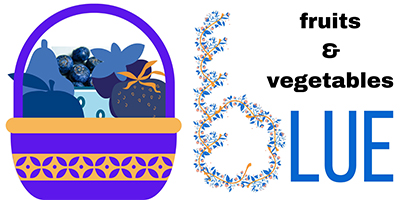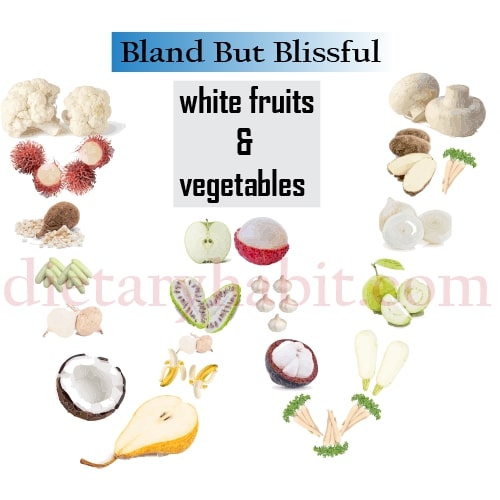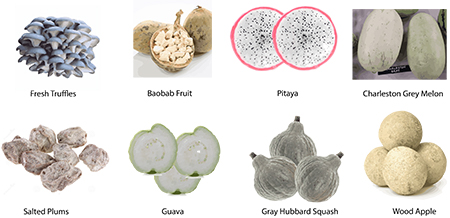Explore 20 Best Blue Vegetables that Offer Delicacy

Despite being one of the more overlooked colors in the produce section, blue vegetables are an important component of a healthy and balanced diet. From blue potatoes to blueberries, these veggies are not only a unique and visually striking addition to any meal, but they also pack a powerful nutritional punch.
In this post, we’ll delve deeper into the world of blue vegetables, exploring their nutritional properties, highlighting some of the most popular types, and offering creative ways to incorporate them into your diet. Whether you’re a seasoned health enthusiast or simply looking to explore new and exciting flavors, the rich blue hue of these vegetables is sure to inspire and captivate. So, join us as we embark on a journey of discovery and learn how to make the most of these under-appreciated yet incredibly valuable blue veggies.
A Complete List of Gray Fruits
Why Blue Vegetables Are Blue
Blue vegetables get their color from natural plant pigments called anthocyanins, which are also responsible for the color of many blue and purple fruits. Anthocyanins are water-soluble flavonoids that produce red, purple, and blue pigments. They are found in the outer layers of some vegetables and fruits, giving them their distinctive blue hue.
The concentration of anthocyanins can vary depending on factors such as the plant variety, growing conditions, and ripeness. Generally, blue vegetables with a darker color tend to have a higher concentration of anthocyanin, which also means they are richer in antioxidants and other beneficial nutrients.
Interestingly, some blue vegetables can actually turn green when cooked due to changes in the pH level. For example, blue peas can turn green when cooked, while blue cabbage can turn pink. Nevertheless, blue vegetables are a unique and nutritious addition to any diet, and their distinctive color is sure to add some visual interest to your plate.
Types of Blue Vegetables
Let me introduce with you some of the astounding naturally occurring blue vegetables names you see less often.
Blue potatoes
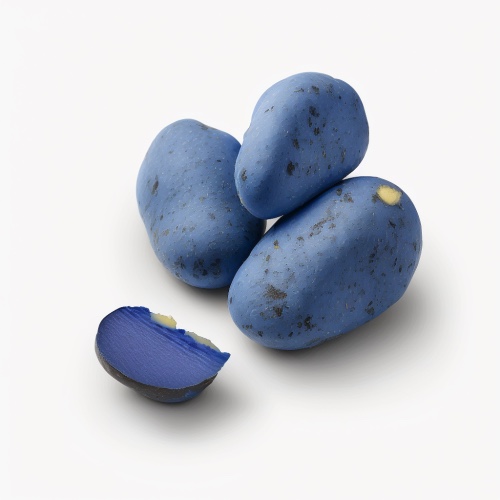
Blue potatoes have a unique bluish-purple skin and flesh. They’re a great source of potassium and vitamin C, and they contain antioxidants called anthocyanins, which give them their blue color. Blue potatoes have a slightly sweet taste and a fluffy texture, making them a versatile ingredient in a range of dishes. They can be boiled, roasted, mashed, or fried, and can be used in salads, soups, or stews. Blue potatoes can also be served as a side dish, baked, or used as a substitute for regular potatoes in traditional dishes like shepherd’s pie.
Blue corn
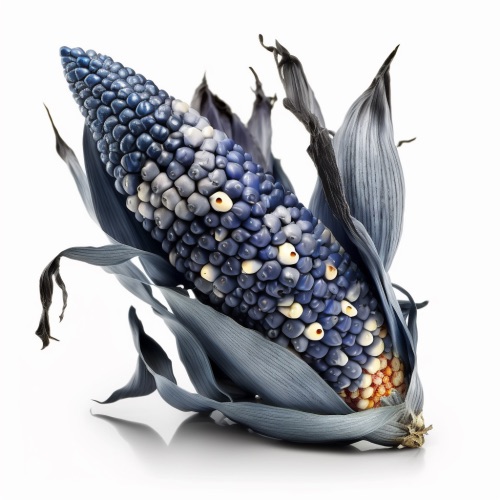
Blue corn is a variety of corn that has a blue or purplish color. It has a nuttier, earthier flavor than yellow corn, and it’s a good source of fiber, antioxidants, and essential nutrients like magnesium and phosphorus. Blue corn can be used to make a range of dishes, including tortillas, chips, and polenta. It’s also a popular ingredient in Mexican cuisine, where it’s used to make dishes like blue corn tamales and blue corn enchiladas.
Blue corn tortillas and chips are a great alternative to traditional yellow corn tortillas and chips, and they’re an excellent source of whole grains. Blue corn can also be used to make a flavorful and healthy breakfast cereal or added to salads for a colorful and nutritious twist.
Blue sweet potatoes
Blue sweet potatoes are a type of sweet potato with a bluish-purple skin and a deep orange flesh. They’re high in fiber, vitamin A, and antioxidants, and they have a slightly sweet, nutty flavor. Blue sweet potatoes are a versatile ingredient that can be used in a range of dishes, including roasted as a side dish, mashed, or baked.
They can also be used to make sweet potato fries, or added to soups, stews, and curries. Blue sweet potatoes are a great substitute for regular sweet potatoes, adding a colorful and nutritious twist to traditional recipes. They can also be a beautiful addition to a vegetable tray or a salad, adding a pop of color and nutrition to any meal.
Blue cauliflower
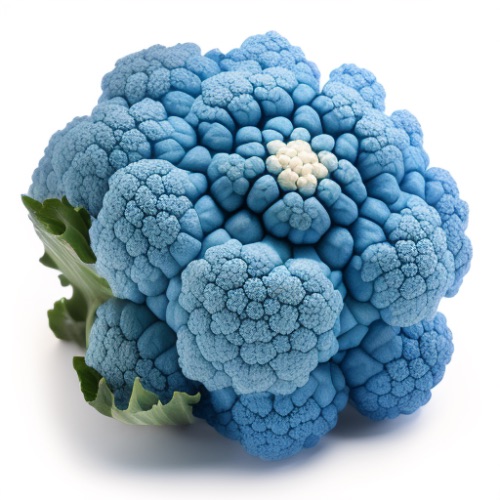
Blue cauliflower is a unique and striking variety of cauliflower with a deep blue or purple color. This blue vegetable is not only beautiful, but it is also highly nutritious, with a range of health benefits. Blue cauliflower is packed with antioxidants, fiber, and essential vitamins and minerals like vitamin C, vitamin K, and potassium.
When it comes to taste, blue cauliflower has a mild, slightly sweet flavor that is similar to regular cauliflower, but with a slightly nuttier taste. This makes it a great ingredient in a range of dishes, from roasted cauliflower steaks to a colorful and nutritious addition to salads and veggie bowls.
To prepare blue cauliflower, simply trim the leaves and base of the cauliflower and break it into florets. It can be steamed, roasted, or sautéed, just like regular cauliflower. The vibrant blue color of blue cauliflower can make it an eye-catching ingredient in a range of dishes, and it’s a great way to add color and nutrition to any meal.
Blue string beans

Blue string beans, also known as purple or blue-podded beans, are a vibrant and nutritious variety of green beans. These beans have a unique, deep purple color that is truly eye-catching, making them a great choice for adding color to your plate.
In addition to their striking appearance, blue string beans are also highly nutritious. They are a good source of fiber, vitamin C, and antioxidants, which help to protect the body against free radicals and reduce inflammation. The beans have a slightly sweeter and more delicate flavor than regular green beans, making them a delicious and healthy addition to any meal.
To prepare blue string beans, simply trim the ends and wash the beans thoroughly. They can be cooked in a range of ways, including steaming, boiling, sautéing, or roasting. Blue string beans can be enjoyed as a side dish, tossed in a salad, or even used in soups and stews for an extra pop of color and nutrition.
Blue carrots
Blue carrots, also known as purple or black carrots, are a striking and delicious variety of carrot with a deep purple color. These carrots are not only visually stunning, but they also offer a range of health benefits. They’re rich in antioxidants, fiber, and essential vitamins and minerals, such as vitamin A and potassium.
In terms of taste, blue carrots have a slightly sweeter and earthier flavor than regular orange carrots, with a slightly nutty taste. This makes them a great ingredient in a range of dishes, from roasted carrots to colorful and nutritious addition to salads and veggie bowls.
To prepare blue carrots, simply wash and peel the outer layer. They can be roasted, boiled, or eaten raw, depending on your preference. The vibrant color of blue carrots makes them a beautiful ingredient in any dish, adding a pop of color and nutrition to your meal.
Blue kale
Blue kale, also known as Russian or Siberian kale, is a striking and nutritious variety of kale with a blue-green color. This leafy green vegetable is packed with vitamins, minerals, and antioxidants, making it a great addition to any healthy diet.
In terms of taste, blue kale has a slightly sweeter and more delicate flavor than regular kale, with a slightly nutty taste. This makes it a great ingredient in a range of dishes, from salads to sautés and soups.
To prepare blue kale, simply remove the tough stem from the leaves and wash thoroughly. The leaves can be cooked in a range of ways, including steaming, sautéing, or blanching. Blue kale can be enjoyed as a side dish or used as an ingredient in a range of dishes.
The stunning blue-green color of blue kale makes it a beautiful addition to any dish, adding a pop of color and nutrition to your meal. And with its many health benefits, including high levels of vitamin K, vitamin A, and antioxidants, blue kale is a great choice for anyone looking to add some variety and nutrition to their diet.
Blue asparagus
Blue asparagus, also known as the “sapphire of the vegetable kingdom,” is a rare and prized variety of asparagus with a striking blue-purple color. Legend has it that blue asparagus was discovered by a band of mischievous leprechauns who, in a fit of boredom, decided to paint some ordinary asparagus with blueberry juice. While this may or may not be true, one thing is for sure: blue asparagus is a unique and delicious addition to any meal.
In terms of taste, blue asparagus has a slightly sweeter and more delicate flavor than regular green asparagus, with a slightly nutty and earthy taste. This makes it a great ingredient in a range of dishes, from grilled asparagus to creamy soups.
To prepare blue asparagus, simply wash the spears and trim off the woody ends. They can be cooked in a range of ways, including grilling, roasting, or sautéing. Blue asparagus can be enjoyed as a side dish or used as an ingredient in a range of dishes.
Blue lettuce
Blue lettuce, also known as Lollo Bionda lettuce, is a unique and visually striking variety of lettuce with a delicate blue-green color and curly leaves. This tender and flavorful lettuce is packed with nutrition and is a great choice for anyone looking to add some variety and flavor to their salads and other dishes.
In terms of taste, blue lettuce has a slightly sweet and nutty flavor, with a refreshing crunch that adds texture to any dish. It’s a versatile ingredient that can be used in a range of recipes, from salads to sandwiches and wraps.
To prepare blue lettuce, simply wash the leaves thoroughly and dry them carefully. They can be used in a range of salads and dishes, either as the main ingredient or as a complementary addition to other greens.
Blue tomatoes
Blue tomatoes, also known as “Smurftastic Tomatoes,” are a unique and unusual variety of tomato that are sure to catch the eye (and taste buds) of any adventurous foodie. With their deep blue-purple hue, these tomatoes look like they were plucked straight out of a magical garden in a fairytale land.
But don’t let their fantastical appearance fool you – blue tomatoes are just as delicious and nutritious as their red counterparts. They have a slightly sweeter and milder flavor than traditional tomatoes, with a juicy and firm texture that is perfect for slicing and adding to sandwiches or salads.
So how do you prepare and serve blue tomatoes? Well, they can be used in a range of dishes, from traditional tomato sauces to grilled salads and sandwiches. One fun way to incorporate them into your meals is to use them as a unique and colorful topping for a homemade pizza or as a garnish for a Bloody Mary cocktail.
Aside from their stunning color, blue tomatoes are also packed with nutrients like vitamin C, potassium, and antioxidants. So not only do they look great on your plate, but they also help keep you healthy and feeling your best.
Blue bell peppers
Blue bell peppers, also known as blue sweet peppers, are a beautiful and unique addition to any kitchen. Their deep blue-purple color makes them stand out from other bell peppers, and their sweet and mild flavor makes them a versatile ingredient for a variety of recipes.
In terms of appearance, blue bell peppers are similar in shape and size to traditional bell peppers, but their skin has a vibrant blue-purple color. They have a slightly thicker skin than other bell peppers, which gives them a firm texture and helps them retain their shape when cooked.
When it comes to taste, blue bell peppers are slightly sweeter than green or red bell peppers, but still have a mild flavor that pairs well with a range of other ingredients. They are great for adding color and flavor to salads, stir-fries, or roasted vegetable medleys.
In terms of nutrition, blue bell peppers are rich in antioxidants, vitamins A and C, and fiber. This makes them a healthy choice for anyone looking to boost their nutrient intake and support their overall health.
To prepare blue bell peppers, simply wash them thoroughly and cut off the top and bottom. Slice them in half and remove the seeds and white membranes. From there, they can be sliced, diced, or stuffed with your favorite ingredients.
Blue artichokes
Blue artichokes are a stunning and flavorful variety of the traditional green artichoke. With their deep blue-purple hue and delicate flavor, they are a true gourmet delight that is sure to impress any food lover.
Blue artichokes are similar in appearance and preparation to their green counterparts. They have a round, globe-like shape with thorny leaves that need to be trimmed before cooking. Once prepared, blue artichokes have a tender heart and meaty, flavorful leaves that are perfect for dipping in sauces or adding to salads.
One of the most unique features of blue artichokes is their striking color, which is due to the presence of anthocyanins, a type of antioxidant that gives them their blue-purple hue. These antioxidants are known to have a range of health benefits, including anti-inflammatory and anti-cancer properties.
In terms of nutrition, blue artichokes are packed with fiber, vitamins C and K, and minerals like potassium and magnesium. They are also low in calories, making them a great addition to any healthy eating plan.
When it comes to cooking and serving blue artichokes, there are a variety of delicious options. They can be roasted, grilled, boiled, or steamed, and served with a variety of dipping sauces, like aioli or lemon butter. They can also be added to pizzas, salads, or pasta dishes for a gourmet touch.
Blue pumpkins
Blue pumpkins, also known as Blue Hubbard pumpkins, are a unique and stunning variety of pumpkin that make a great addition to any autumnal dish. With their vibrant blue-green skin and sweet, nutty flavor, they are a true delight for the senses.
In terms of appearance, blue pumpkins are larger than other pumpkin varieties, with a thick, tough skin that helps them retain their shape during cooking. Their skin has a blue-green hue with distinctive, bumpy ridges, making them a beautiful centerpiece for any autumnal table setting.
When it comes to taste, blue pumpkins have a sweet, nutty flavor that pairs well with a variety of spices and ingredients. They are delicious roasted or baked, and can be used in a variety of recipes, from savory soups to sweet pies and cakes.
In terms of nutrition, blue pumpkins are packed with vitamins and minerals, including vitamin A, potassium, and fiber. They are also low in calories, making them a great choice for anyone looking to maintain a healthy diet.
To prepare blue pumpkins, simply wash them thoroughly and cut them in half. Scoop out the seeds and fibers from the center, then roast or bake them until they are tender and golden brown. From there, they can be used in a variety of recipes, from soups and stews to baked goods and desserts.
Blue radicchio
Blue radicchio is a vibrant and flavorful vegetable that is sure to make any dish stand out. With its striking purple-blue leaves and slightly bitter taste, it adds a pop of color and depth of flavor to any meal.
Radicchio is a member of the chicory family and is grown in the cooler months of the year. Blue radicchio is a variety that is distinguished by its deep blue or purple leaves. When it comes to taste, blue radicchio has a slightly bitter flavor with a nutty undertone, making it a perfect addition to salads or as a side dish.
When it comes to cooking and serving blue radicchio, there are a variety of delicious options. It can be used in salads, risottos, or grilled as a side dish. Its vibrant color and slightly bitter taste add depth and complexity to any meal, making it a favorite among chefs and home cooks alike.
Blue radicchio is a versatile and delicious vegetable that is sure to add a pop of color and flavor to any dish. It is packed with nutrients and offers a slightly bitter taste that balances well with a variety of flavors. So if you’re looking to add a little pizzazz to your plate, give blue radicchio a try – your taste buds (and your body) will thank you.
Blue turnips
Blue turnips are a lesser-known variety of turnip that are gaining popularity for their unique flavor and stunning appearance. With their blueish-purple skin and white flesh, they add a striking and vibrant pop of color to any dish.
In terms of taste, blue turnips have a slightly sweet and nutty flavor that is less bitter than other varieties of turnips. They are also slightly less starchy, making them a great choice for those looking to reduce their carbohydrate intake.
Blue turnips are also packed with nutrients. They are an excellent source of vitamin C, which supports a healthy immune system, and also contain fiber, which promotes healthy digestion. In addition, they are low in calories, making them a great choice for anyone looking to maintain a healthy diet.
In addition to their delicious taste and nutritional benefits, blue turnips are also a visually stunning addition to any dish. Their bright blueish-purple skin is sure to catch the eye and add a pop of color to any plate.
Blue endive
Blue endive, also known as blue chicory or blue leafy endive, is a beautiful and flavorful vegetable that adds a sophisticated touch to any dish. Its vibrant blueish-purple leaves are strikingly beautiful and its slightly bitter taste make it a favorite of chefs and home cooks alike.
Blue endive is a type of leafy vegetable that is often used in salads, but can also be cooked and served in a variety of other ways. Its slightly bitter flavor is perfectly balanced by its nutty undertones, making it a versatile ingredient that complements a wide variety of flavors.
In addition to its delicious taste, blue endive is also packed with nutrients. It is a great source of vitamin K, which is important for bone health and blood clotting, and also contains antioxidants that can help protect the body against cellular damage.
When it comes to cooking and serving blue endive, there are many delicious options. It can be used in salads, sandwiches, and wraps, or cooked and served as a side dish. Its striking appearance makes it a popular choice for garnishing plates and adding visual interest to any dish.
Blue peas
Blue peas, also known as blue butterfly peas or blue borage peas, are a unique and strikingly beautiful vegetable that are prized for their vibrant blueish-purple color. In addition to their aesthetic appeal, blue peas are also packed with nutrition and flavor, making them a popular choice for chefs and home cooks alike.
Blue peas are a good source of protein, fiber, and essential vitamins and minerals. They are also high in antioxidants, which have been shown to help prevent cellular damage and reduce the risk of chronic diseases.
When it comes to cooking and serving blue peas, there are many delicious options. They can be used in soups, stews, and curries, or simply cooked and served as a side dish. In addition, blue peas can be used to make colorful and flavorful dips, spreads, and sauces.
One of the unique features of blue peas is their ability to change color when exposed to acidic ingredients such as lemon juice or vinegar. This makes them a versatile ingredient that can be used to create a wide variety of stunning and colorful dishes.
In addition to their culinary uses, blue peas are also used in traditional medicine for their therapeutic properties. They have been shown to have anti-inflammatory, antidiabetic, and anti-anxiety effects, among others.
Blue squash
Ah, the blue squash – a truly delightful member of the blue vegetable family! With its soft, delicate flesh and subtle, earthy flavor, this beautiful squash is a true culinary gem.
Now, I know what you’re thinking – “blue squash? I’ve never heard of that before!” But fear not, my friends, because this underappreciated veggie is here to add a touch of color and excitement to your meals.
In terms of nutrition, blue squash is no slouch. It’s packed with vitamins, minerals, and fiber, and is a low-calorie addition to any meal. And let’s be real, who doesn’t love a vegetable that’s both delicious and good for you?
When it comes to cooking, blue squash is a versatile ingredient that can be used in a variety of dishes. You can roast it, grill it, sauté it, or even puree it into a soup. And the best part? Its vibrant blueish hue adds a touch of whimsy and fun to any plate.
Blue eggplant
The blue eggplant, also known as the “Turkish Orange” eggplant, is a gorgeous and flavorful vegetable that deserves a place on your plate. With its stunning deep blue-purple skin and creamy white flesh, the blue eggplant is a feast for the eyes as well as the taste buds.
In terms of flavor, the blue eggplant has a mild and slightly sweet taste, making it a versatile ingredient that can be used in a wide variety of dishes. It’s especially popular in Mediterranean and Middle Eastern cuisine, where it’s often used in stews, dips, and grilled dishes.
From a nutritional standpoint, the blue eggplant is a great source of fiber, potassium, and antioxidants. It’s also low in calories and fat, making it a healthy addition to any meal.
One of the best things about the blue eggplant is its versatility in the kitchen. You can slice it and grill it, roast it in the oven, or sauté it with your favorite spices and herbs. It’s also a great ingredient for dips and spreads, and pairs well with other Mediterranean staples like hummus and tzatziki.
Blue zucchini
The blue zucchini – a delightful and colorful twist on a classic vegetable! With its vibrant blue-green skin and tender flesh, the blue zucchini is a unique and eye-catching addition to any plate.
In terms of flavor, the blue zucchini is similar to its green counterpart – it has a mild and slightly sweet taste, making it a versatile ingredient that can be used in a variety of dishes. It’s a great source of fiber, vitamins, and minerals, and is low in calories, making it a healthy addition to any meal.
When it comes to cooking, the blue zucchini is just as versatile as the green variety. You can sauté it, grill it, roast it, or even spiralize it into noodles for a fun and healthy pasta alternative. And of course, its blue hue adds a touch of whimsy and fun to any plate.
One of the best things about the blue zucchini is its visual appeal. Its unique color and shape make it a great ingredient for Instagram-worthy dishes and can help make your meals stand out. And let’s be honest, who doesn’t love a vegetable that’s both delicious and beautiful?
Why Are There Less Naturally Occurring Blue Vegetables
The scarcity of naturally occurring blue vegetables might make you wonder, ‘Is there any blue vegetables in the world?’ Naturally occurring blue vegetables are relatively rare compared to other colors of vegetables. This is because the blue pigment in plants, anthocyanin, is less stable than other pigments like chlorophyll or carotenoids. Anthocyanins are easily degraded by heat, light, and changes in pH, which can cause the color to fade or change.
Furthermore, many blue vegetables are not commonly grown or consumed in large quantities. For example, blue potatoes, blue carrots, and blue corn are not as widely available as their more common counterparts, and therefore are not as well known to the public. They suit more as garnishes rather than main food.
Health Benefits of Blue Vegetables
Blue vegetables are not only eye-catching and delicious but are also incredibly nutritious. Here are some of the top nutritional benefits of incorporating blue vegetables into your diet:
- High in Antioxidants: Blue vegetables are rich in anthocyanins, which are pigments that give the vegetables their blue or purple color. Anthocyanins are powerful antioxidants that help protect the body against damage from free radicals, reduce inflammation, and support heart health.
- Rich in Fiber: Most blue vegetables are high in fiber, which is essential for maintaining good digestive health, preventing constipation, and promoting a feeling of fullness, which can help with weight management.
- Good Source of Vitamins and Minerals: Blue vegetables are rich in vitamins and minerals that are essential for overall health, such as vitamin C, vitamin K, potassium, and iron.
- Low in Calories: Many blue vegetables are low in calories, making them a great addition to a balanced diet. They are also low in fat and carbohydrates, which makes them a good choice for those who are watching their weight.
- May Reduce the Risk of Chronic Diseases: Blue vegetables have been linked to a reduced risk of chronic diseases such as heart disease, diabetes, and cancer. The antioxidants in blue vegetables help to protect cells from damage and inflammation, which can lead to chronic diseases over time.
How to Incorporate Blue Vegetables into Your Diet
Now that you know about the nutritional benefits of blue vegetables, you may be wondering how to incorporate them into your diet. Here are some tips to help you get started:
- Try Roasting: Roasting blue vegetables like blue cauliflower, blue sweet potatoes, or blue carrots can bring out their natural sweetness and flavor. Simply cut them into bite-sized pieces, toss them with a little bit of oil, salt, and pepper, and roast them in the oven until tender and caramelized.
- Make a Salad: Add blue lettuce, blue radicchio, or blue endive to your next salad for a pop of color and flavor. You can also add blue peas and blue tomatoes for extra texture and taste.
- Use Blue Vegetables in Soups and Stews: Blue vegetables like blue squash, blue potatoes, and blue turnips are perfect for adding to soups and stews. They add flavor, texture, and nutrition to your dishes.
- Make Blue Vegetable Chips: Slice blue potatoes, blue sweet potatoes, or blue squash thinly and bake them in the oven for a healthy and delicious snack. You can also use blue kale leaves to make crispy kale chips.
- Blend Blue Vegetables into Smoothies: Blue vegetables like blue kale, blue peas, and blue cauliflower are great additions to smoothies. Simply blend them with your favorite fruits and some almond milk or yogurt for a nutritious and refreshing drink.
- Use Blue Vegetables as a Side Dish: Blue vegetables can also be used as a side dish. Simply steam or sauté them with some garlic and herbs, and serve them alongside your main course.
Ending Notes
If you’re looking for a simple and effective way to boost your health and add some variety to your diet, incorporating blue vegetables is an excellent choice. These colorful veggies offer a range of nutrients that can help improve your overall health and well-being, and they can be enjoyed in many different ways.
Remember, it’s important to vary your diet and include a range of colorful fruits and vegetables to ensure you’re getting all the nutrients your body needs. By incorporating blue vegetables into your meals, you’ll not only add some beautiful color to your plate, but you’ll also be giving your body a valuable dose of nutrients. So, don’t be afraid to get creative and experiment with different ways to enjoy blue vegetables!

